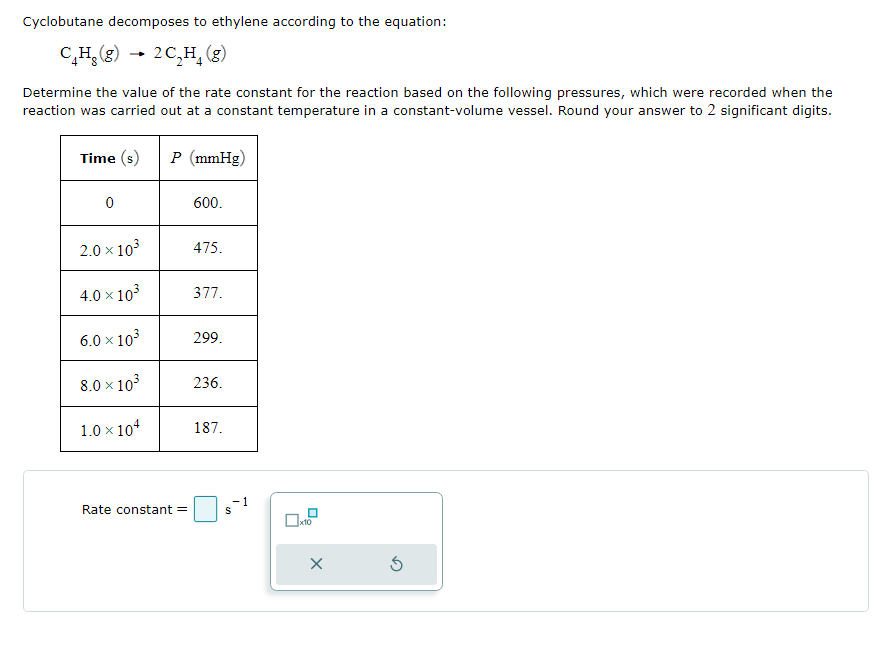Cyclobutane decomposes to ethylene according to the equation: CH₂(g) → 2C₂H₂ (g) Determine the value of the rate constant for the reaction based on the following pressures, which were recorded when the reaction was carried out at a constant temperature in a constant-volume vessel. Round your answer to 2 significant digits. Time (s) P (mmHg) 0 2.0 x10³ 4.0 × 10³ 6.0 × 10³ 8.0 x10³ 1.0×104 Rate constant = 600. 475. 377. 299. 236. 187. -1 S x10
Cyclobutane decomposes to ethylene according to the equation: CH₂(g) → 2C₂H₂ (g) Determine the value of the rate constant for the reaction based on the following pressures, which were recorded when the reaction was carried out at a constant temperature in a constant-volume vessel. Round your answer to 2 significant digits. Time (s) P (mmHg) 0 2.0 x10³ 4.0 × 10³ 6.0 × 10³ 8.0 x10³ 1.0×104 Rate constant = 600. 475. 377. 299. 236. 187. -1 S x10
Chemistry & Chemical Reactivity
10th Edition
ISBN:9781337399074
Author:John C. Kotz, Paul M. Treichel, John Townsend, David Treichel
Publisher:John C. Kotz, Paul M. Treichel, John Townsend, David Treichel
Chapter14: Chemical Kinetics: The Rates Of Chemical Reactions
Section14.4: Concentration-time Relationships: Integrated Rate Laws
Problem 14.5CYU: Sucrose, a sugar, decomposes in acid solution to give glucose and fructose. The reaction is...
Related questions
Question

Transcribed Image Text:Cyclobutane decomposes to ethylene according to the equation:
CH₂(g) 2C₂H₂(g)
Determine the value of the rate constant for the reaction based on the following pressures, which were recorded when the
reaction was carried out at a constant temperature in a constant-volume vessel. Round your answer to 2 significant digits.
Time (s) P (mmHg)
0
2.0 × 10³
4.0 × 10³
6.0 × 10³
8.0 × 10³
1.0 x 104
Rate constant =
600.
475.
377.
299.
236.
187.
-1
S
x10
X
S
Expert Solution
This question has been solved!
Explore an expertly crafted, step-by-step solution for a thorough understanding of key concepts.
This is a popular solution!
Trending now
This is a popular solution!
Step by step
Solved in 3 steps

Knowledge Booster
Learn more about
Need a deep-dive on the concept behind this application? Look no further. Learn more about this topic, chemistry and related others by exploring similar questions and additional content below.Recommended textbooks for you

Chemistry & Chemical Reactivity
Chemistry
ISBN:
9781337399074
Author:
John C. Kotz, Paul M. Treichel, John Townsend, David Treichel
Publisher:
Cengage Learning

Chemistry & Chemical Reactivity
Chemistry
ISBN:
9781133949640
Author:
John C. Kotz, Paul M. Treichel, John Townsend, David Treichel
Publisher:
Cengage Learning

Chemistry: Principles and Practice
Chemistry
ISBN:
9780534420123
Author:
Daniel L. Reger, Scott R. Goode, David W. Ball, Edward Mercer
Publisher:
Cengage Learning

Chemistry & Chemical Reactivity
Chemistry
ISBN:
9781337399074
Author:
John C. Kotz, Paul M. Treichel, John Townsend, David Treichel
Publisher:
Cengage Learning

Chemistry & Chemical Reactivity
Chemistry
ISBN:
9781133949640
Author:
John C. Kotz, Paul M. Treichel, John Townsend, David Treichel
Publisher:
Cengage Learning

Chemistry: Principles and Practice
Chemistry
ISBN:
9780534420123
Author:
Daniel L. Reger, Scott R. Goode, David W. Ball, Edward Mercer
Publisher:
Cengage Learning

Chemistry: The Molecular Science
Chemistry
ISBN:
9781285199047
Author:
John W. Moore, Conrad L. Stanitski
Publisher:
Cengage Learning

Principles of Modern Chemistry
Chemistry
ISBN:
9781305079113
Author:
David W. Oxtoby, H. Pat Gillis, Laurie J. Butler
Publisher:
Cengage Learning

Chemistry
Chemistry
ISBN:
9781305957404
Author:
Steven S. Zumdahl, Susan A. Zumdahl, Donald J. DeCoste
Publisher:
Cengage Learning